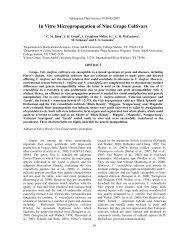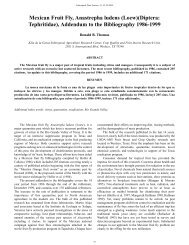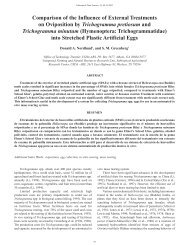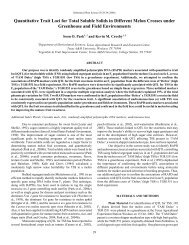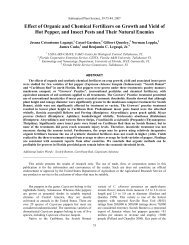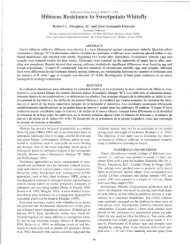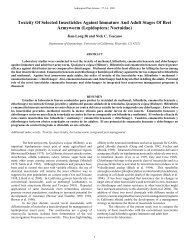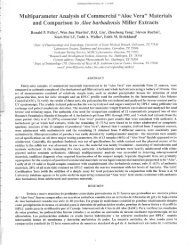Subtropical Plant Sci. J. 52:1-7. - Subtropical Plant Science Society
Subtropical Plant Sci. J. 52:1-7. - Subtropical Plant Science Society
Subtropical Plant Sci. J. 52:1-7. - Subtropical Plant Science Society
You also want an ePaper? Increase the reach of your titles
YUMPU automatically turns print PDFs into web optimized ePapers that Google loves.
<strong>Subtropical</strong> <strong>Plant</strong> <strong>Sci</strong>ence, <strong>52</strong>: 1-<strong>7.</strong>2000<br />
received from R.A. Dean (Wechter et al., 1995) were also<br />
included in this study. Quantitative and qualitative analyses of<br />
DNAs were determined by a UV-VIS scanning<br />
spectrophotometer (UV-2101PC, Shimadzu). All DNA<br />
samples measured a ratio of A260/A280 above 1.8.<br />
Bulk segregant analysis. The bulk DNAs from both<br />
crosses ‘Ananas Yokneam’ x MR-1 and ‘Vedrantais’ x<br />
‘PI 161375’ were prepared similar to the method of<br />
Michelmore et al. (1991). For the bulk DNAs from ‘Ananas<br />
Yokneam’ x MR-1, homozygous resistant bulk DNAs (referred<br />
to as resistant bulks) were prepared by mixing equal amounts<br />
of 4 individual F2 homozygous resistant DNA samples.<br />
Likewise, the mixed resistant bulk DNAs contained equal<br />
amounts of 4 F2 homozygous resistant individual DNA samples<br />
and 11 F2 heterozygous resistant individual DNA samples. The<br />
susceptible bulk DNAs contained equal amounts of 8 F2<br />
susceptible individual DNA samples. For the bulk DNAs from<br />
‘Vedrantais’ x PI 161375, the resistant bulk contained equal<br />
amounts of 46 F2 homozygous resistant DNA samples, and the<br />
susceptible bulk DNAs contained equal amount of 47 F2<br />
susceptible DNA samples.<br />
Polymerase Chain Reaction (PCR). The PCR conditions<br />
used for RAPD analyses in this study were modified from<br />
protocols used by Baudracco-Arnas and Pitrat (1996) and<br />
Wechter, et al. (1995) by decreasing the cycle number to 30<br />
cycles because the PCR products were used as inserts in<br />
cloning. Derived SCAR primers were synthesized by Genosys<br />
Biotechologies, Inc, 1442 Lake Front Cir. Ste 185, The<br />
Woodlands, Texas. PCRs were run on a DNA Thermal Cycler<br />
480 (Perkin-Elmer). Cycle parameters were 5 min at 95ºC,<br />
followed by 36 - 40 cycles of 1min at 95ºC, 1 min at 40ºC for<br />
RAPD primer or 64ºC for SCAR primers, 2 min at 72ºC, with<br />
a 10 min at 72ºC extension at the end. PCR products were<br />
electrophoresed at 3 - 5 V/cm in a 1.2 % agarose (Sigma) gels<br />
in 1 x TAE buffer and stained with 0.5 g/L ethidium bromide.<br />
Cloning and sequencing. First, the RAPD fragments of<br />
1.55 kb amplified from the resistant line ‘PI 161375’ were<br />
cloned and sequenced (see below for details). After<br />
electrophoresing PCR products, the target bands were cut out<br />
from agarose gel. The DNA fragments were resuspended in<br />
dH2O by using either Geneclean II Kit or Spin Module, (Bio<br />
101 Inc. La Jolla, CA), whereas PCR products (single<br />
fragment) amplified from derived primers were used directly<br />
for cloning sometimes. Either the Original TA Cloning Kit<br />
(Invitrogen Corp. San Diego, CA) or Promega pGEM — T<br />
Easy Vector Systems (Promega Corp. Madison, WI) was used<br />
and the manufacturer’s protocols were followed for ligations<br />
and transformations. To identify correct clones, 4 - 6 putative<br />
clones were picked up and cultured in LB medium individually<br />
and subsequently following plasmid preparation, EcoRI<br />
restriction endonuclease digestion, and gel electrophoresis to<br />
check the inserts. The correct clone(s) showed a fragment that<br />
corresponded to their PCR products. The nucleotide sequences<br />
of the cloned fragments were determined by using an<br />
automated DNA Sequencer Model 377 located at the DNA<br />
Sequencing/Synthesis Facility, Iowa State University, Ames,<br />
IA. Then the SCAR primers were constructed based on former<br />
sequence data and synthesized by Genosys Biotechologies, Inc.<br />
Software. GCG package version 8.0 (Genetics Computer<br />
Group, Madison, WI) and BLAST were used for sequence<br />
analyses and database comparative searches.<br />
Southern blot and DNA hybridization. The PCR products<br />
were electrophoresed in 1.0 % agarose (Sigma) gels at 3 V/cm<br />
for 4 h in TAE buffer. DNA blots were prepared as follows.<br />
After electrophoresis, gels were treated with 10 volume of 0.25<br />
N HCl for 10 -15 min and then with 0.4 M NaOH for 20 min<br />
with gentle shaking. DNAs were blotted onto Hybond-N +<br />
membranes (Amersham Life <strong>Sci</strong>ence Inc., Arlington Heights,<br />
IL) for 2-3 h in an alkali-downward capillary blotting<br />
procedure (Zheng and Wolff, 1999) that was modified from<br />
Koetsier et al. (1993).<br />
Clone-derived PCR fragment 1.55 kb which originated<br />
from PCR amplification from the resistant parental line ‘PI<br />
161375’, was used as a hybridization probe. To purify the<br />
inserts to be used as probes, the plasmids containing<br />
corresponding inserts were digested with EcoRI. After<br />
electrophoresis of the digestion products, the corresponding<br />
bands were cut out from the agarose gel and were purified and<br />
resuspended in dH2O by using either Geneclean II Kit or Spin<br />
Module, (Bio 101 Inc. La Jolla, CA). The non-radioactive<br />
labeling and detection system (Amersham Life <strong>Sci</strong>ence Inc.,<br />
Arlington Heights, IL) was used in probe labelings,<br />
hybridizations, stringency washings, blockings and antibody<br />
incubations, and signal generations and detection as modified<br />
from Zheng and Wolff (1999). The blots were exposed on<br />
Hyperfilm-MP for 5-60 min before developing the films.<br />
RESULTS<br />
Amplification of a 1.55 kb RAPD fragment from<br />
resistant melon cultigens. Fig. 1 shows the PCR profiles<br />
amplified from genomic DNAs of some melon cultigens (Table<br />
2) by using the RAPD primer 596 (Wechter et al., 1995). The<br />
1.55 kb RAPD fragment was found in 23 out of the total of 36<br />
(64 %) resistant cultigens tested, including the parental line<br />
‘PI161375’ (lane 1) and ‘MR-1’ (lane 3) in Fig.1, but in none<br />
of the 30 susceptible genotypes which included two F1 varieties<br />
‘Mission’ and ‘Morning Ice’ (Table 2).<br />
Detection of the RAPD fragment in bulked DNA pools.<br />
To evaluate the segregation of the RAPD fragment with the<br />
resistance, the bulked DNAs from two segregating populations<br />
were used. Fig. 2 showed the 1.55 kb fragment was amplified<br />
from both homozygous and heterozygous resistant bulked<br />
DNA pools that derived from either the cross ‘Vedrantais’ x ‘PI<br />
161375’ or ‘Ananas Yokneam’ x ‘MR-1’, but not from the<br />
susceptible bulked DNA pools accordingly.<br />
DNA sequence of the RAPD fragment. Two<br />
independent clones that contained the 1.55 kb fragment<br />
amplified from the resistant parental line ‘PI 161375’ were<br />
used for sequencing the inserts. The consensus sequences<br />
were found after performing the computer analysis using the<br />
GAP program of the GCG package. Six hundred and five and<br />
584 nucleotides from each end were sequenced using primers<br />
T7-1 and R-1, respectively. Comparative searches of the<br />
nonredundant DNA databases accessible through the<br />
National Center for Biotechnology Information (Bethesda, MD,<br />
4



